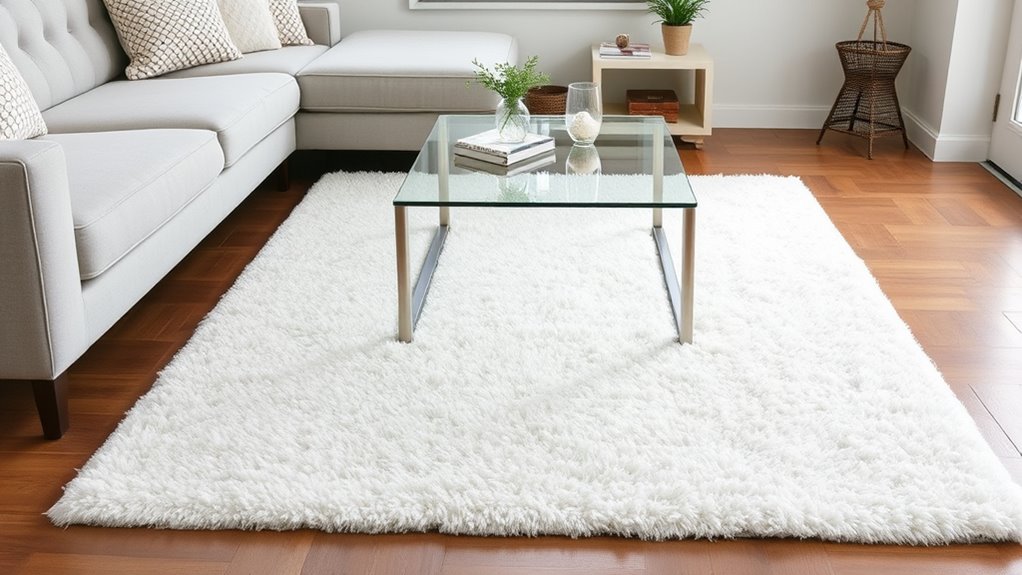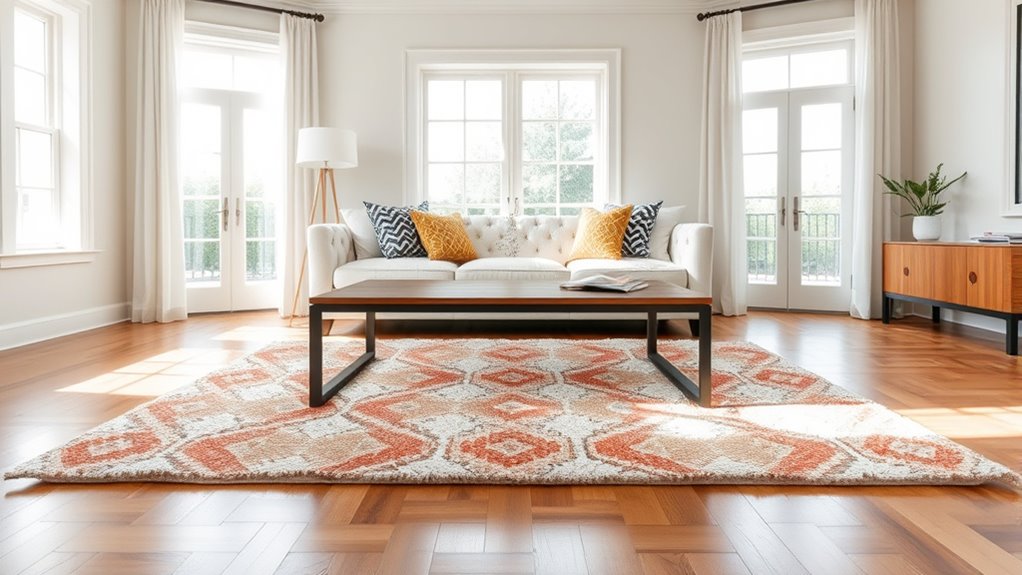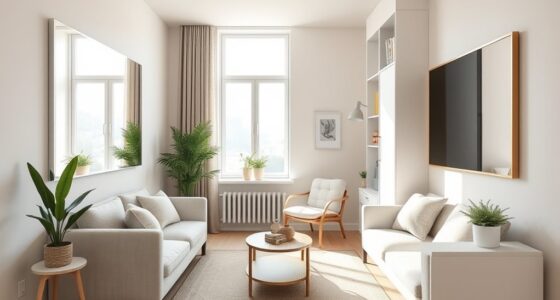To avoid rug sizing mistakes, always measure your space carefully before buying. Make sure the rug is proportionate to your furniture and room shape—big enough to anchor seating or dining areas, but not so large that it overcrowds. Avoid tiny rugs that break up your space or oversized ones that feel overwhelming. Matching the rug shape to the room’s layout creates harmony. Keep these tips in mind to select the perfect size — and more insights await you if you keep exploring.
Key Takeaways
- Measure your space carefully to select a rug that fits proportionally within the room.
- Ensure the rug extends beyond furniture edges to create a cohesive and balanced look.
- Match rug shape and size to your room’s layout for visual harmony.
- Avoid choosing rugs that are too small or overpowering, maintaining proper room proportions.
- Consider furniture placement, ensuring front legs sit on the rug for a unified design.

Choosing the right rug size might seem simple, but many homeowners make mistakes that can disrupt the flow and style of a space. The first mistake is selecting a rug that’s too small for the area. When your rug doesn’t extend beyond the furniture, it can make the room look disjointed and less cohesive. Imagine having a sofa and chairs with a tiny rug tucked underneath; it creates the illusion that the furniture is floating or disconnected from the rest of the room. To avoid this, measure your space carefully and aim for a rug that either fits under all your main furniture pieces or at least extends enough to unify the seating area.
A rug that doesn’t extend beyond furniture creates a disjointed, less cohesive space.
Another common error is not considering the shape and layout of your room. For rectangular spaces, choosing a rectangular rug that matches the room’s dimensions works best, but many people opt for round rugs or irregular shapes that don’t complement the room’s structure. If you have a square or rectangular space, select a rug that aligns with those lines to create a balanced look. Conversely, in irregularly shaped rooms, a custom-sized rug can help anchor the space without feeling out of place.
You also want to be cautious about the rug’s size relative to the furniture. For dining areas, the rug should be large enough that when chairs are pulled out, they remain on the rug. An undersized rug in this scenario makes the furniture look awkward and can even cause damage to your flooring when chairs scrape against it. In living rooms, a good rule of thumb is to have the front legs of sofas and chairs sit on the rug. This anchors the furniture and makes the space feel more intentional. If the rug is too small, the furniture appears disconnected; if it’s too large, it can overpower the room and make it feel cramped.
Finally, pay attention to the proportions of your room and furniture. A rug that’s too large can dominate the space, making it feel crowded, while one that’s too small can seem out of place and throw off the balance. Before buying, visualize how the rug will sit within the room, considering the scale of your furniture and the overall layout. Additionally, incorporating natural materials like wool or jute in your rug can add to the farmhouse aesthetic and warmth of the space. If you follow these guidelines—measuring carefully, aligning the shape with the room, and matching the rug size to your furniture—you’ll avoid the most common sizing mistakes and create a harmonious, stylish space.
Frequently Asked Questions
How Do I Measure Irregularly Shaped Rooms for Rug Size?
To measure irregularly shaped rooms, first sketch the space and identify the key areas you want the rug to cover. Use a measuring tape to record the longest and widest points, including any unique angles or alcoves. For complex shapes, consider dividing the room into smaller sections, measuring each, and then selecting a rug size that best covers the main areas. This approach guarantees your rug fits perfectly.
What Rug Size Works Best for High-Traffic Areas?
Did you know that the right rug size can extend its lifespan by up to 30%? For high-traffic areas, opt for a large rug that covers most of the space, ideally leaving a border of about 12-18 inches around the edges. This helps protect the rug’s edges from wear and tear, while also creating a cohesive look. Choose a durable material like wool or nylon for added resilience.
Should Rugs Be Larger or Smaller Than Furniture?
Your rug should be slightly larger than your furniture to create a balanced look. Ideally, it extends beyond the edges of sofas and chairs by 6 to 12 inches, giving your space a cohesive feel. Smaller rugs can make furniture appear floating or disconnected, while larger ones anchor the room. Measure carefully and consider the layout to make certain your rug enhances your space without overwhelming or underwhelming it.
How Do I Choose the Right Rug Size for Open-Plan Spaces?
To choose the right rug size for open-plan spaces, measure your area first. Aim for a rug that either defines each zone or ties the space together, typically 6-12 inches smaller than the room’s dimensions. You want enough floor showing around the edges. Consider furniture placement—ensure front legs rest on the rug—so the space feels cohesive and inviting without overwhelming or underwhelming the area.
Can I Layer Different Rug Sizes Effectively?
Yes, you can layer different rug sizes effectively. To do this, start with a larger rug as a base, then add smaller rugs on top to define spaces and add visual interest. Make sure the rugs complement each other in color and style to create cohesion. Keep the edges aligned or slightly offset for an intentional look. This approach adds depth and personality to your space without overwhelming it.
Conclusion
Now that you know the common rug sizing mistakes, you’re better equipped to avoid them. Remember, choosing the right size can make or break your space, so don’t cut corners. When you measure twice and buy once, you save yourself headaches down the line. It’s better to get it right the first time than to be caught between a rock and a hard place. Trust your instincts and let your perfect rug tie the room together effortlessly.









